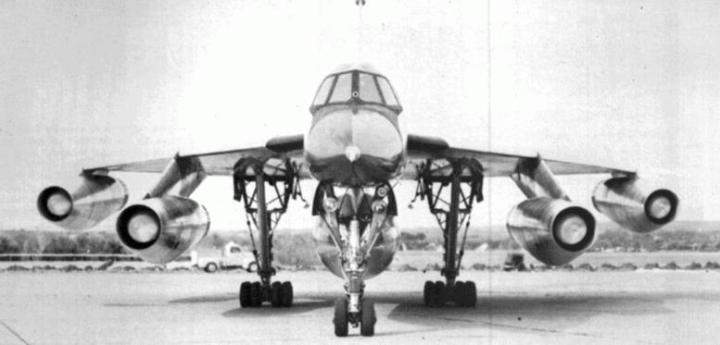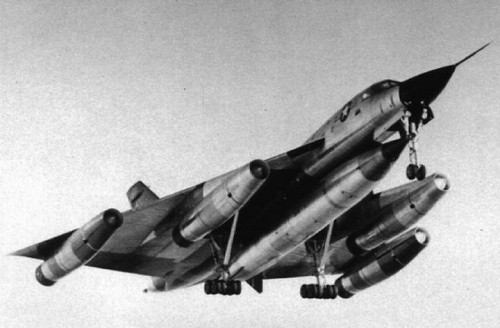Scott Locklin continues his irregular series on machinery that, in one way or another, is utterly compelling. Today a crazy machine from a crazy time.
Aerospace technology became grotesque and beautiful in the 1950s. One of the most grotesque and beautiful creations of that bizarre era of technological excellence was the Convair B-58 Hustler (top).
As I have said before, the early supersonic era is one of my favorite epochs of aerospace technology. Not because the products of this era were particularly effective: most of them were spectacular failures. I love this era of technology because it is beautiful. The creations of this time stretched technologies to the absolute limits. It is the embodiment of a tremendous strain of the human technological spirit, grasping after the unattainable ideal. It is the technological manifestation of the look on the face of the Olympic weight lifter, as his joints crack and sinews pop, straining every muscle fiber to accomplish the impossible goal.
What was the B-58? Convair more or less took its F-102 airframe, multiplied its linear dimensions by 1.5 or so, strapped four enormous engines to the wings, stuck a machine gun on its tail, and called it a Supersonic Bomber. The engines were so fuel hungry, the only practical way to get the thing to Russia was to integrate the bomb with the external fuel tank, but it worked. It was bristling with new technologies. In addition to its ability to travel at ludicrous speeds, the B-58 would actually talk to its pilots in a lady-like voice which they called sexy-Sally (or “the bitch” since it always delivered bad news). Yeah, your dumb iPhone will also do this, but imagine what some corn-pone who used to pilot a big aluminum dump truck like the B-17 made of this! It must have been considered something like magic.

Other innovative technologies: the airframe used a sophisticated aluminum honeycomb and fiberglass composite material. The ejection seats were wacky clamshell devices to make it possible for all 3 occupants of the aircraft to eject safely. It had several sophisticated radars and avionics that included an accurate inertial guidance system that used a sort of electric star sextant, doppler radar, and electric compass to reset the drift (probably utilizing some analog electro-mechanical Kalman filter like ideas, which is pretty neat if you’re a signal processing nerd).
The combat doctrine of the era was that nuclear weapon equipped bombers would fly very high, and go very fast, to avoid enemy interceptors. This, effectively, was the combat doctrine of WW-2, applied to the supersonic era. This actually made sense for a brief period: it was very difficult to shoot down a B-29 in late WW-2 which flew too high for most interceptors. In order for interceptors to shoot down the B-29, they would have to gain altitude very quickly, and be able to beat the speed of the B-29, which was considerable. Remember, the B-58 was flying only 12 years after the introduction of the B-29. It was conceived a mere 5 years after the deployment of the B-29. What happened 5 years ago, technologically speaking, in modern aerospace technology? 5 years ago is pretty much last week. I think 5 years ago, we were saying the F-35 would fly in 5 years. Which is pretty much what we’re saying today. But the 40s and 50s were a different era. People were more serious, and technological advance was happening so quickly, combat doctrine couldn’t keep up.

What was the effect of the B-58? Well, for one thing, it freaked out the Soviets. The built a whole new generation of ridiculously fast supersonic interceptors to deal with it. They also built their own supersonic bombers, like the Tu-22 ”Blinder” pictured below. They built a giant radar network, so they could at least see the things coming in time to send something up to get the B-58. They also invested heavily in surface to air missile technology, which eventually made the B-58 irrelevant.
The B-58 was rendered irrelevant by surface to air missiles almost as soon as it was deployed, but it earned a reprieve by virtue of being reasonably good at flying low, under the SAM radar. Even so, it was preposterously expensive to purchase and operate. It was estimated to cost its weight in gold. The subsonic B-52, conceived years before, was almost as good at flying under the radar as the Hustler was, and it cost a lot less, carried more boom and had a much larger combat radius. Truth be told, the altitude and cruising speed of a B-52 wasn’t all that different from that of a B-58 either; the Hustler could only maintain supersonic flight while burning tremendous amounts of fuel. While the supersonic dash capability of the B-58 might have made it a more survivable platform in the event of a nuclear war … since a nuclear war with the Soviets would have been the end of civilization, it really doesn’t matter much if the B-58 survives, does it? What’s it going to do when it gets back? In an uncharacteristic display of intelligence, Robert McNamera decided to phase out the Hustler in 1965, a mere 5 years after it was first deployed, and was completely retired by 1970. I don’t think he did it for the right reasons, as McNamera was one of the most cement-headed SecDefs we have ever had, but at least he did it.

What can be learned from the experience of the B-58? I think it is clear by now: we don’t need supersonic bombers. We don’t need supersonic anything to drop bombs. Supersonic flight doesn’t help much in this role, and the compromises the capability inflicts are not worth the trouble or the money. The other supersonic-capable bomber we deployed, the B-1B, was never particularly useful either, other than as a nuclear codpiece for freaking out Russian people. The only way a very fast, high flying bomber could conceivably be useful is if it goes very high, and very fast, at which point it’s basically an insanely expensive, pointlessly reusable ICBM anyway.
The other thing we can learn from this: yesterday’s combat doctrine isn’t very helpful. We’re presently engaged in developing a next generation stealth bomber, as if the last generation were not expensive enough. While I admit the utility of a stealth bomber for strategic targets, or the early parts of a war on a third world country, I’m not sure why we need more than we already have. Finally, absurdly expensive weapons systems are almost never worth the money. While we’ve gone through several generations of “advanced” bombers since the Hustler, when we need to drop lots of bombs, the venerable B-52, a 1948 design, is still the tool of choice.

Still, I’m glad the B-58 was built. It’s a crazy machine, from a crazy time.












Top stuff, Scott. The fifties did produce some crazy and wacky looking aircraft and Convair seemed to produce their fair share; the B-36, with it’s four jet and six piston engines, comes to mind.
Back in the early 1960s, the Strategic Air Command ran exercises including test runs against American cities, one of them Cleveland. One evening a B-58 making such a run produced a sonic boom that about caused my grandmother, visiting from a much quieter city, to about do a back flip out of her chair. I don’t know that I ever saw one, but I did hear a number of them.
“it was very difficult to shoot down a B-29 in late WW-2 which flew too high for most interceptors. In order for interceptors to shoot down the B-29, they would have to gain altitude very quickly, and be able to beat the speed of the B-29, which was considerable.”
And of course, for all the hullabaloo over the Norden sight, it was also difficult to hit what one aimed at from that altitude. LeMay ended up sending them in at very low level at night, and simply burned down large areas of the Japanese cities.